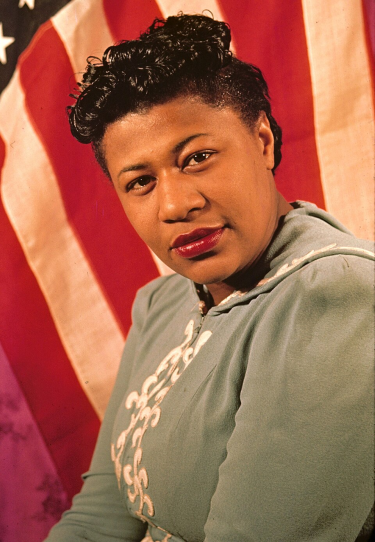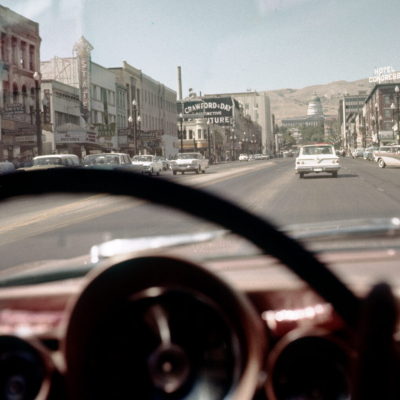.
.

Douglas Brinkley,
author of
Rosa Parks
.
_______
.
Rosa Parks, an African American seamstress in 1955 Alabama, had no idea she was changing history when, work-weary, she refused to surrender her seat to a white passenger on a segregated bus. Now she is immortalized for the defiance that sent her to jail and triggered a bus boycott that catapulted Martin Luther King, Jr., into the national spotlight. Who was she, before and after her historic act?*
Douglas Brinkley, a familiar and respected television commentator on a wide range of historical, documentary, and news programs, serves as Director of the Eisenhower Center for American Studies and is Distinguished Professor of History at the University of New Orleans. A noted biographer and editor, he has published major volumes on Dean Acheson, Jimmy Carter, FDR, James Forrestal, Jean Monnet, Theodore Roosevelt and Rosa Parks.
He shares his thoughts on Rosa Parks with Jerry Jazz Musician publisher Joe Maita in a February, 2003 interview.
.
.
“I was determined to achieve the total freedom that our history lessons taught us we were entitled to, no matter what the sacrifice. When I declined to give up my seat, it was not that day, or bus, in particular. I just wanted to be free like everybody else. I did not want to be continually humiliated over something I had no control over: the color of my skin.”
– Rosa Parks
.
_______
.
JJM I enjoyed reading your biography of Rosa Parks, and was surprised by the depth of her activism, to tell you the truth, because where I went to school there wasn’t a lot taught about her beyond her refusal to move to the back of the bus. I was left with the impression that she was a courageous woman who happened to be at the right place at the right time to make a statement, but after reading your work, clearly she was much deeper and substantially more involved in the civil rights movement than that.
DB That’s right.
JJM You wrote, “Sometimes it seemed as if Rosa Parks were two people: one, a traditionally submissive Negro laborer, the other, a modern African-American woman bold enough to demand her civil rights.” Who was Rosa Parks?
DB Rosa Parks was born in a racist Tuskeegee, Alabama community, at a time when the Jim Crow system reigned in the South and the echoes of slavery’s whip were still present, when voting rights were denied African Americans, and where African American women were often raped by white men with no legal repercussions against them. So, she was like so many African American women in the South, beginning with a broken home situation, never having any money, and not having any kind of equal access to anything. In order to survive in that kind of climate, she had to learn to deal with the white segregationist system. That is the side of Rosa Parks that was always mild mannered in many ways, who, as a seamstress, needed to mind her own business if she intended to be employed in the homes of the local whites. The other side of Rosa Parks — while that kindly face was put forward — was of someone whose pot was simmering all the time. Anger filled her about all the inequities she encountered around every bend. Eventually, on December 1, 1955, like a volcano she erupted, and refused to move to the back of the bus, which became the opening salvo of the civil rights movement.
JJM Was she involved in the civil rights community prior to her actions on the bus?
DB Very much so, yes. She was a secretary for the Montgomery branch of the NAACP, and ran the office of Mr. E.D. Nixon. People like Thurgood Marshall and the NAACP people in New York knew her for a long time. Examples of her activism include getting thrown off a bus in the forties, and organizing African American students to march on a public library to allow them the freedom to check out books from a “whites only” facility. She was going to sue the state of Alabama for the right to vote because they kept denying it. She was constantly pushing the envelope for equal rights for African Americans. What grounded her, and kept her two sides together, was the African Methodist Episcopalian Church. She was a true product of the A.M.E. church, and a devout Christian. It was from a kind of Christian perspective that she approached civil rights.
JJM Her husband Raymond had quite an impact on her activism as well.
DB Raymond Parks was one of the people involved with the Scottsboro Boys case, and he led the legal defense fund in the state of Alabama. He was a barber, in whose shop many African Americans would meet and read the black newspapers out of Pittsburgh and Chicago and New York. They would talk about how to smash Jim Crow in the South. So yes, she was politicized by her husband.
JJM Prior to Rosa Parks’ refusal to move to the back of the bus, there was another African American woman, Claudette Colvin, who refused to give up her seat on a bus in March of 1955. Why wasn’t that the incident that sparked the boycott?
DB Claudette Colvin was a teenaged girl, eating a candy bar while sitting in the “whites only” section of a bus. The bus driver barked at her in racist terms to move, but she refused. She was arrested in front of the Dexter Avenue church, where she was handcuffed and dragged from the bus. The national NAACP was about to make her the prime case to challenge segregation follwing the Brown v. Topeka ruling, but because Colvin was an unwed pregnant teenager, she ended up being deemed an unacceptable candidate by the black leadership.
JJM What was the immediate personal fallout to Rosa Parks over her protests?
DB Once the bus driver, James Blake, asked her to move and she said no, and the police took Parks to the police station, finger printed her and put her in jail, all around Montgomery, the 50,000 African Americans were in disbelief because Parks was well known as a kind of saintly figure in the community. Ricocheting all over town were comments of disbelief. “They arrested Rosa Parks? How low can they get for arresting her?” From that moment, she became the spiritual symbol of the Montgomery bus boycott, while Dr.King became the voice. The two of them, in a kind of collaborative fashion, ended up turning all the eyes of the world to Montgomery, and the drama going there. The victory of the bus boycott, of course, ultimately made Rosa Parks’ a household name. Yet, during this time, she was receiving many death threats from white supremacists, and many in the black leadership of the Montgomery boycott were jealous of her because she was suddenly famous and they weren’t. The major television networks and newspapers wanted to talk to Rosa Parks and not them. Thus, she felt suddenly not at home and displaced in Montgomery, so in 1957 she left and moved to Detroit, where her brother Sylvester worked.
JJM And it was in Detroit that her views toward non-violent protest changed…
DB She always admired Dr. King for his true belief in Gandhian principles of non-violence. But Rosa Parks, although she seemed meek and demure, felt that if you are slapped once in your face, you turn your cheek, and that if you are slapped again you turned your cheek again, but if somebody slaps you a third time, you have to strike back. So, she wasn’t a pure pacifist. She didn’t believe in violence for violence sake, but believed that in order to maintain one’s personal dignity and integrity, one had to stand up for their rights.
JJM Martin Luther King, who you describe as being forever linked to Rosa Parks, said this about her: “I’m happy it happened to a person like Rosa Parks, for nobody can doubt the height of her character, nobody can doubt the boundless outreach of her integrity.” In the end, did she have any regrets about being the instigator of the boycott?
DB Rosa Parks never coveted fame or celebrityhood, but they came to her, and she was treated as the mother of the civil rights movement and an icon. It is a role she was never entirely comfortable with. On the other hand, history created this reality about her, and she ended up carrying herself decade after decade with a great deal of poise and dignity and courage in confronting what she considered racist affronts or inequalities in any guise. One of the things about Rosa Parks is, because she is part white, part Cherokee Creek Indian and part African American, she never got hung up on “I am a black person.” She is not into black politics. She was much more into the sense of the issues of teaching tolerance concerning skin color and religion. In those ways, she was very high minded in her approach to global politics. It wasn’t one of race versus race or screaming at each other, it was one of tolerance.
.
_______
.
.
Rosa Parks
by
Douglas Brinkley
.
*
.
Douglas Brinkley and Rosa Parks
.
_______
.
.
Interview took place on February 18, 2003
.
.
If you enjoyed this interview, you may want to read our interview with Jackie Robinson biographer Scott Simon.
.
.
*
.
.
* From the publisher
.
.
.







































